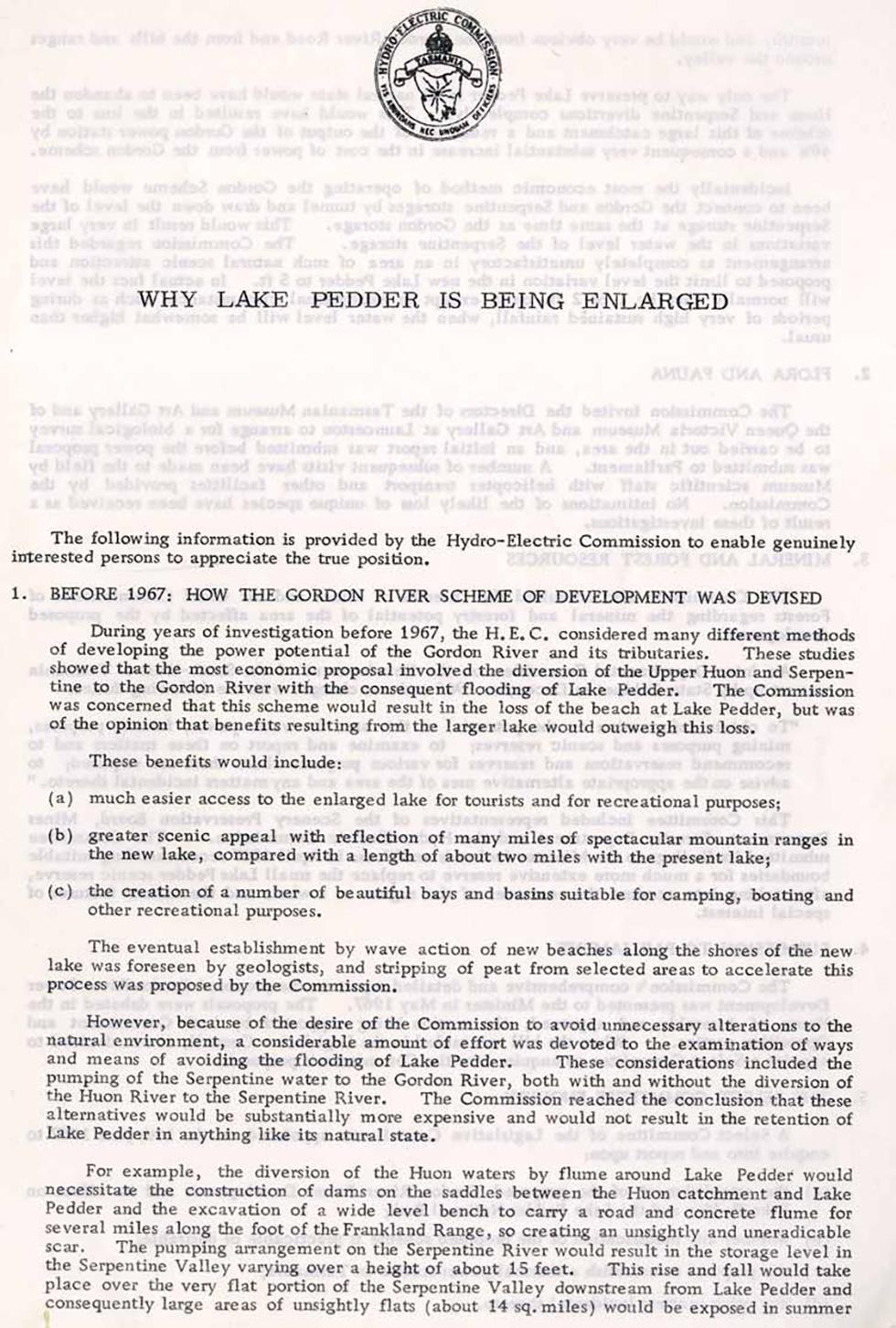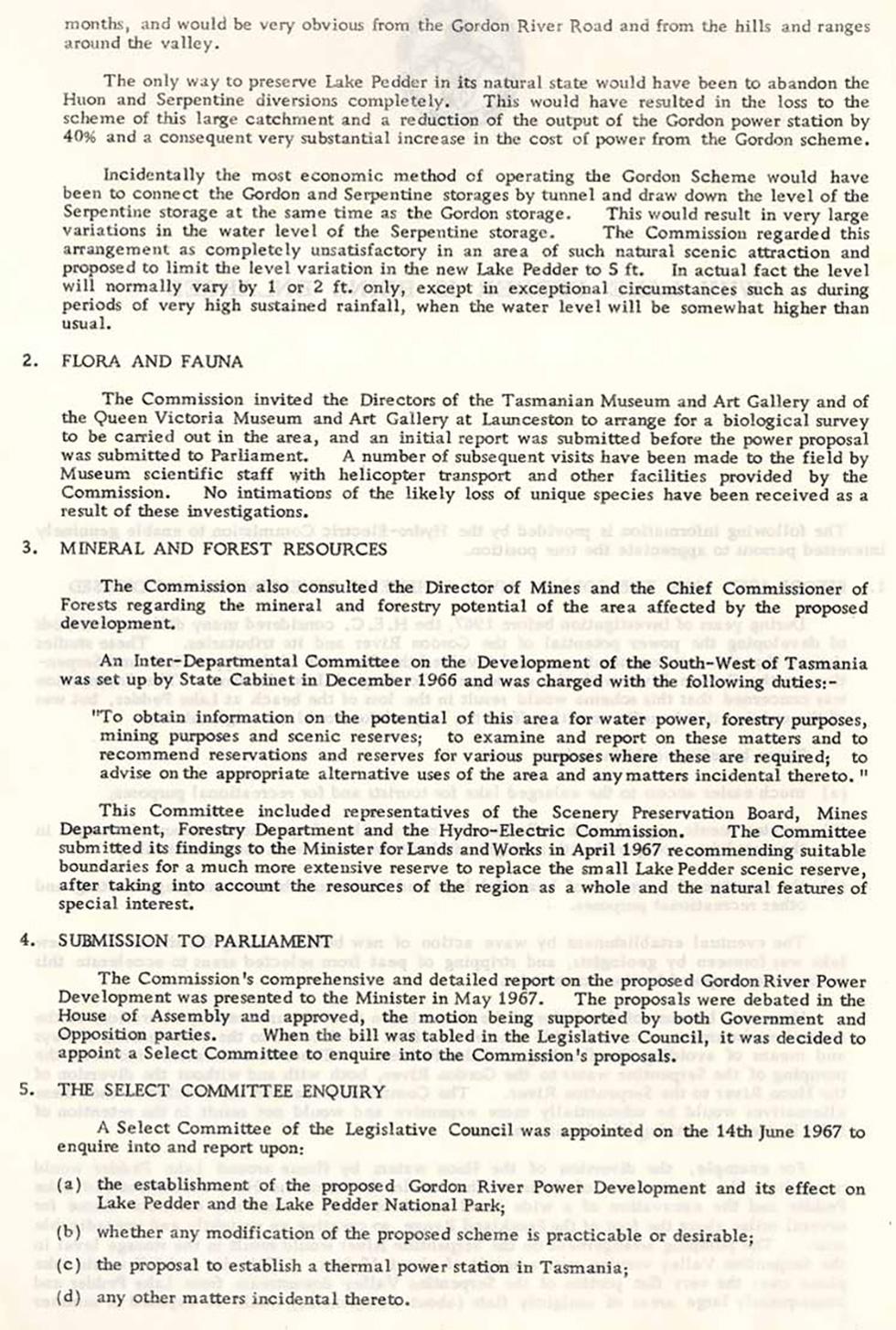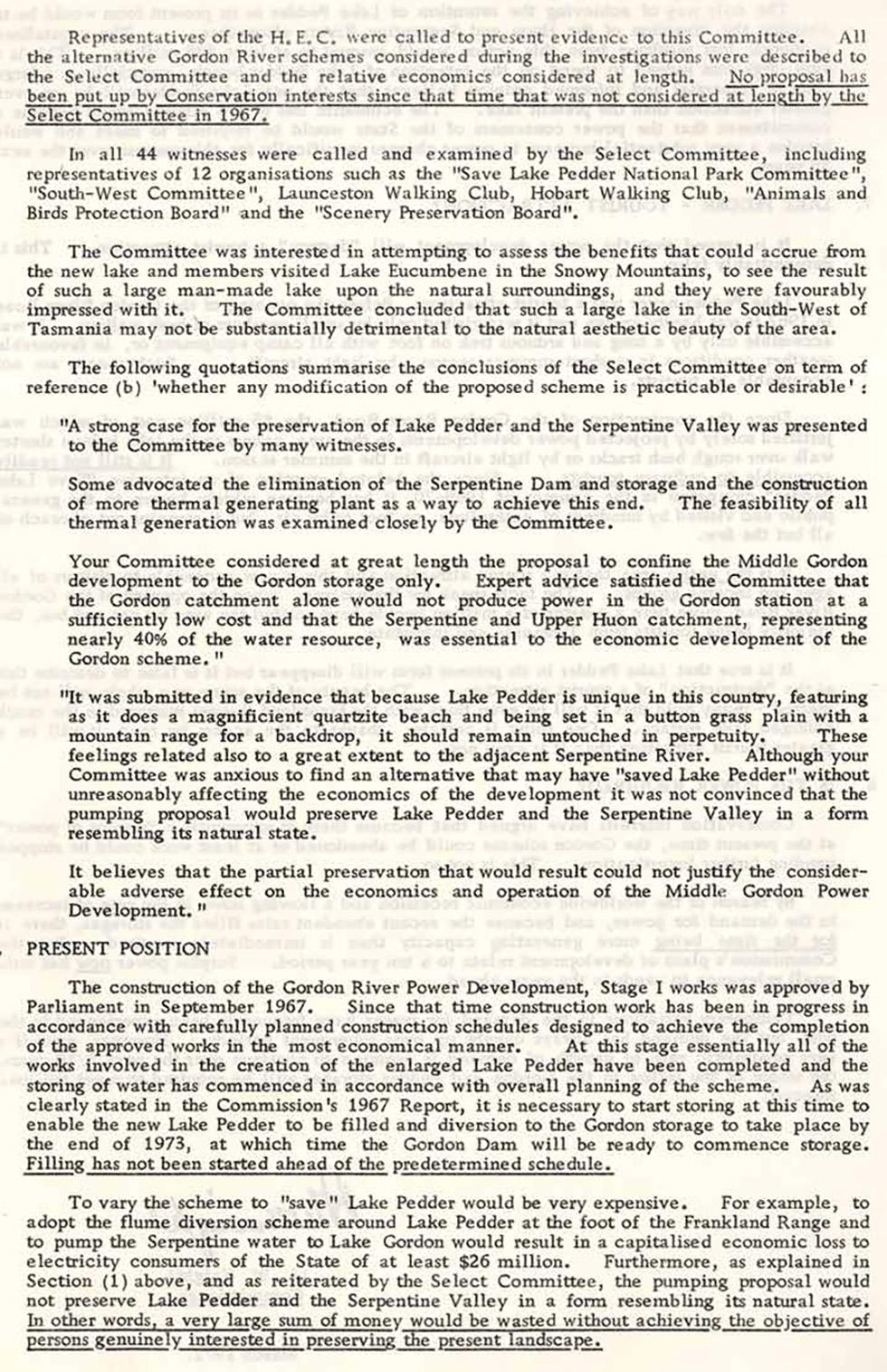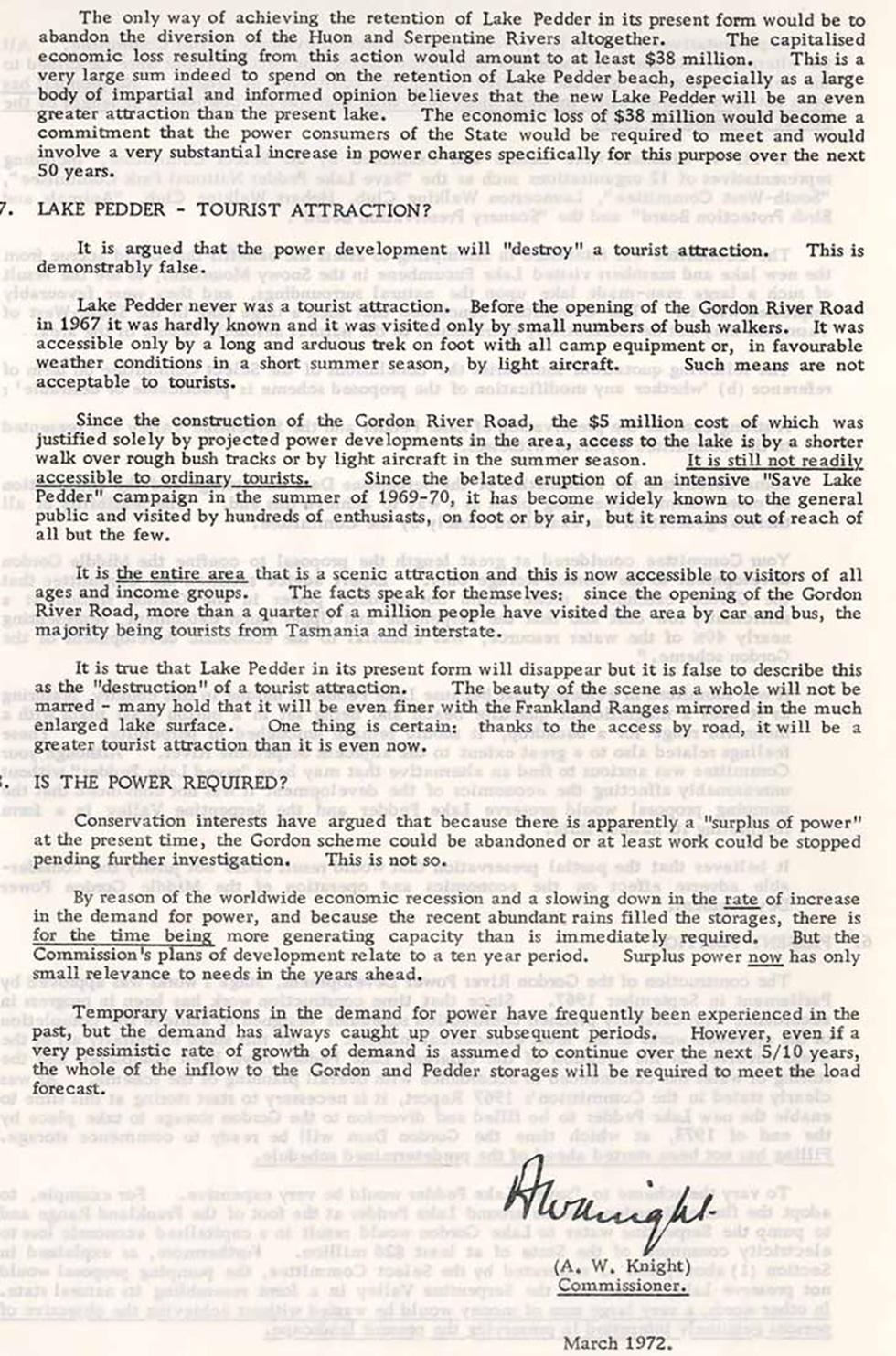



Aboriginal and Torres Strait Islander people should be aware that the National Archives' website and collection contain the names, images and voices of people who have died.
Some records include terms and views that are not appropriate today. They reflect the period in which they were created and are not the views of the National Archives.





[Page 1]
[Crest of the Hydroelectric Commission]
WHY LAKE PEDDER IS BEING ENLARGED
The following information is provided by the Hydro-Electric Commission to enable genuinely interested persons to appreciate the true position.
1. BEFORE 1967: HOW THE GORDON RIVER SCHEME OF DEVELOPMENT WAS DEVISED
During years of investigation before 1967, the H.E.C considered many different methods of developing the power potential of the Gordon River and its tributaries. These studies showed that the most economical proposal involved the diversion of the Upper Huon and Serpentine to the Gordon River with the consequent flooding of Lake Pedder. The Commission was concerned that this scheme would result in the loss of the beach at Lake Pedder, but was of the opinion that benefits resulting from the larger lake would outweigh this loss.
These benefits would include:
(a) much easier access to the enlarged lake for tourists and for recreational purposes;
(b) greater scenic appeal with reflection of many miles of spectacular mountain ranges in the new lake, compared with a length of about two miles with the present lake;
(c) the creation of a number of beautiful bays and basins suitable for camping, boating and other recreational purposes.
The eventual establishment by wave action of new beaches along the shores of the new lake was foreseen by geologists, and stripping of peat from selected areas to accelerate this process was proposed by the Commission.
However, because of a desire of the Commission to avoid unnecessary alterations to the natural environment, a considerable amount of effort was devoted to the examination of ways and means of avoiding the flooding of Lake Pedder. These considerations included the pumping of the Serpentine water to the Gordon River, both with and without the diversion the Huon River to the Serpentine River. The Commission reached the conclusion that these alternatives would be substantially more expensive and would not result in the retention of Lake Pedder in anything like its natural state.
For example, the diversion of the Huon waters by flume around Lake Pedder would necessitate the construction of dams on the saddles between the Huon catchment and Lake Pedder and the excavation of a wide level bench to carry a road and concrete flume for several miles along the foot of the Frankland Range, so creating an unsightly and uneradicable [sic.] scar. The pumping arrangement on the Serpentine River would result in the storage level in the Serpentine Valley downstream from Lake Pedder and consequently large areas of unsightly flats (about 14 sq. miles) would be exposed in summer
[Page 2]
months, and would be very obvious from the Gordon River Road and from the hills and ranges around the valley.
The only way to preserve Lake Pedder in its natural state would have been to abandon the Huon and Serpentine diversions completely. This would have resulted in the loss to the scheme of this large catchment and a reduction of the output of the Gordon power station by 40% and a consequent very substantial increase in the cost of power from the Gordon scheme.
Incidentally the most economic method of operating the Gordon Scheme would have been to connect the Gordon and Serpentine storages by tunnel and draw down the level of the Serpentine storage at the same time as the Gordon storage. This would result in very large variations in the water level of the Serpentine storage. The Commission regarded this arrangement as completely unsatisfactory in an area of such natural scenic attraction and proposed to limit the level variation in the new Lake Pedder to 5 ft. In actual fact the level will normally vary by 1 or 2 ft. only, except in exceptional circumstances such as during periods of very high sustained rainfall, when the water level will be somewhat higher than usual.
2. FLORA AND FAUNA
The Commission invited the Directors of the Tasmanian Museum and Gallery and of the Queen Victoria Museum and Art Gallery at Launceston to arrange for a biological survey to be carried out in the area, and an initial report was submitted before the power proposal was submitted to Parliament. A number of subsequent visits have been made to the field by Museum scientific staff with helicopter transport and other facilities provided by the Commission. No intimations of the likely loss of unique species have been received as a result of these investigations.
3. MINERAL AND FOREST RESOURCES
The Commission also consulted the Director of Mines and the Chief Commissioner of Forests regarding the mineral and forestry potential of the area affected by the proposed development.
An Inter-Departmental Committee on the Development of the South-West of Tasmania was set up by State Cabinet in December 1966 and was charged with the following duties:-
"To obtain information on the potential of this area for water power, forestry purposes, mining purposes, and scenic reserves; to examine and report on these matters and to recommend reservations and reserves for various purposes where these are required; to advise on the appropriate alternative uses of the area and any matters incidental thereto."
This committee included representatives of the Scenery Preservation Board, Mines Department, Forestry Department, and the Hydro-Electric Commission. The Committee submitted its findings to the Minister for Lands and Works in April 1967 recommending suitable boundaries for a much more extensive reserve to replace the small Lake Pedder scenic reserve, after taking into account the resources of the region as a whole and the natural features of special interest.
4. SUBMISSION TO PARLIAMENT
The Commission's comprehensive and detailed report on the proposed Gordon River Power Development was presented to the Minister in May 1967. The proposals were debated in the House of Assembly and approved, the motion being supported by both Government and Opposition parties. When the bill was table in the Legislative Council, it was decided to appoint a Select Committee to enquire into the Commission's proposals.
5. THE SELECT COMMITTEE ENQUIRY
A Select Committee of the Legislative Council was appointed on the 14th June 1967 to enquire into and report upon:
(a) the establishment of the proposed Gordon River Power Development and its effect on Lake Pedder and the Lake Pedder National Park;
(b) whether any modification of the proposed scheme is practicable or desirable;
(c) the proposal to establish a thermal power station in Tasmania;
(d) any other matters incidental thereto.
[Page 3]
Representatives of the H. E. C. were called to present evidence to this Committee. All the alternative Gordon River schemes considered during the investigations were described to the Select Committee and the relative economics considered at length. No proposal has been put up by Conservation interests since that time that was not considered at length by the Select Committee in 1967. [Underlined]
In all 44 witnesses were called and examined by the Select Committee, including representatives of 12 organisations such as the "Save Lake Pedder National Park Committee", "South-West Committee", Launceston Walking Club, "Animals and Birds Protection Board" and the "Scenery Preservation Board".
The Committee was interested in attempting to assess the benefits that could accrue from the new lake and members visited Lake Eucumbene in the Snowy Mountains, to see the result of such a large man-made lake upon the natural surroundings, and they were favourably impressed with it. The Committee concluded that such a large lake in the South-West of Tasmania may not be substantially detrimental to he natural aesthetic beauty of the area.
The following quotation summarise the conclusion of the Select Committee on term of reference (b) 'whether any modification of the proposed scheme is practicable or desirable' :
"A strong case for the preservation of Lake Pedder and the Serpentine Valley was presented to the Committee by many witnesses.
Some advocated the elimination of the Serpentine Dam and storage and the construction of more thermal generating plant as a way to achieve this end. The feasibility of all thermal generation was examined closely by the Committee.
Your Committee considered at great length the proposal to confine the Middle Gordon development to the Gordon Storage only. Expert advice satisfied the Committee that the Gordon catchment alone would not produce power in the Gordon station at a sufficiently low cost and that the Serpentine and Upper Huon catchment, representing nearly 40% of the water resource, was essential to the economic development of the Gordon scheme."
"It was submitted in evidence that because Lake Pedder is unique in this country, featuring as it does a magnificent quartzite beach and being set in a button grass plain with a mountain range for a backdrop, it should remain untouched in perpetuity. These feelings related also to a great extent to the adjacent Serpentine River. Although your Committee was anxious to find an alternative that may have "saved Lake Pedder" without unreasonably affecting the economics of the development it was not convinced that the pumping proposal would preserve Lake Pedder and the Serpentine Valley in a form resembling its natural state.
It believes that the partial preservation that would result could not justify the considerable adverse effect on the economics and operation of the Middle Gordon Power Development."
6. PRESENT POSITION
The construction of the Gordon River Power Development, Stage I works was approved Parliament in September 1967. Since that time construction work has been in progress in accordance with carefully planned construction schedules designed to achieve the completion of the approved works in the most economical manner. At this stage essentially all of the works involved in the creation of the enlarged Lake Pedder have been completed and the storing of water has commenced in accordance with overall planning of the scheme. As was clearly stated in the Commission's 1967 Report, it is necessary to start storing at this time to enable the new Lake Pedder to be filled and diversion to the Gordon storage to take place by the end of 1973, at which time the Gordon Dam will be ready to commence storage. Filling has not been started ahead of the predetermined schedule. [underlined]
To vary the scheme to "save" Lake Pedder would be very expensive. For example, to adopt the flume diversion scheme around Lake Pedder at the foot of the Frankland Range and to pump the Serpentine water to Lake Gordon would result in a capitalised economic loss to electricity consumers of the State of at least $26 million. Furthermore, as explained in Section (1) above, and as reiterated by the Select Committee, the pumping proposal would not preserve Lake Pedder and the Serpentine Valley in a form resembling its natural state. In other words, a very large sum of money would be wasted without achieving the objective of persons genuinely interested in preserving the present landscape. [Underlined]
[Page 4]
The only way of achieving the retention of Lake Pedder in its present form would be to abandon the diversion of the Huon and Serpentine Rivers altogether. The capitalised economic loss resulting from this action would amount to a least $38 million. This is a very large sum indeed to spend on the retention of Lake Pedder beach, especially as a large body of impartial and informed opinion believes that the new Lake Pedder will be an even greater attraction than the present lake. The economic loss of $38 million would become a commitment that the power consumers of the State would be required to meet and would involve a very substantial increase in power charges specifically for this purpose over the next 50 years.
7. LAKE PEDDER – TOURIST ATTRACTION?
It is argued that the power development will "destroy" a tourist attraction. This is demonstrably false.
Lake Pedder was never a tourist attraction. Before the opening of the Gordon River Road in 1967 it was hardly known and visited by only a small number of bush walkers. It was accessible only by a long and arduous trek on foot with all camp equipment or, in favourable weather conditions in a short summer season, by light aircraft. Such means are not acceptable to tourists.
Since the construction of the Gordon River Road, the $5 million cost of which was justified solely by projected power developments in the area, access to the lake is by a shorter walk over rough bush tracks or by light aircraft in the summer season. It is still not readily accessible to ordinary tourists. [underlined] Since the belated eruption of an intensive "Save Lake Pedder" campaign in the summer of 1969-1970, it has become widely known to the general public and visited by hundreds of enthusiasts, on foot or by air, but it remains out of reach of all but the few.
It is the entire area [underlined] that is a scenic attraction and this is now accessible to visitors of all ages and income groups. The facts speak for themselves: since the opening of the Gordon River Road, more than a quarter of a million have visited the area by car and bus, the majority being tourists from Tasmania and interstate.
It is true that Lake Pedder in its present form will disappear but it is false to describe this as the "destruction" of a tourist attraction. The beauty of the scene as a whole will not be marred – many hold that it will be even finer with the Frankland Ranges mirrored in the much enlarged lake surface. One thing is for certain: thanks to the access by road, it will be a greater tourist attraction than it is even now.
8. IS THE POWER REQUIRED?
Conservation interests have argued that because there is apparently a "surplus of power" at the present time, the Gordon scheme could be abandoned or at least work could be stopped pending further investigation. This is not so.
By reason of the worldwide economic recession and a slowing down in the rate [underlined] of increase in the demand for power, and because the recent abundant rains filled the storages, there is for the time being [underlined] more generating capacity than is immediately required. But the Commission’s plans of development relate to a ten year period. Surplus power now [underlined] has only small relevance to needs in the years ahead.
Temporary variations in the demand for power have frequently been experienced in the past, but the demand has always caught up over subsequent periods. However, even if a very pessimistic rate of growth of demand is assumed to continue over the next 5/10 years, the whole of the inflow to the Gordon and Pedder storages will be required to meet the load forecast.
[Signature]
(A. W. Knight)
Commissioner. [underlined]
March 1972.
Learn how to interpret primary sources, use our collection and more.
